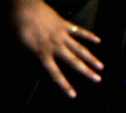Gestures according to power relation
Dead gestures are gestures which have existed in
ancient times and which are not used or understandable today. Like verbal
language, the gesture has birth and death. Every gesture is born based on a
specific cultural background. For example, China is a country with many
nationalities. Among them, the 'Hanna' nationality, with over 90% population, is
the biggest one. In the past centuries, 'Hanna' was conquered by other
nationalities. In that peroid, the living custom of Chinese people was
influenced by the ruling class. For example, in Qing Danasty, Chinese people had
special, in modern eyes, strange ways of expressing meaning which were
influenced of the "Mang" nationality (the ruling class at that time). When men
of similar social status sent greetings to each other, they used the following
gesture,  , but when
noble women met or sent greetings to each other, they use gestures like this one
, but when
noble women met or sent greetings to each other, they use gestures like this one
 ; . The following
picture shows how to meet the emperor
; . The following
picture shows how to meet the emperor



This gesture, called 'koutou', is complicated and
has strict regulations. It consists of three steps:
i) right sleeve brushing the left arm from top to the fingers,
ii) left sleeve brushing the right arm from top to the fingers,
iii) bend down, one knee on the floor, right hand
on the back and left hand hitting the floor.
People had to complete series of actions to say
"yes" and listen the imperial edict, no mistakes were permitted, otherwise
people would be punished. When women met the emperor, they should show pleasant
feelings on their faces in order to please the emperor. The gestures mentioned
above were very popular during the "Qing Dynasty" among the officials and
nobles, but not very popular among the common people. In present, all of them
have died, because the kingdom was overthrowed and the ruling class was changed.
These gestures disappeared quickly. We can only see them in movies, but the
descendants of "Mang" in Beijing are proud and glad to talk about their great
history .
In 1970s (the culture revolution), China was under
the leadership of Mao, people used series of gestures and emotions to show their
loyalty to him and their confidence in the revolution. Please, see the following
two pictures

"I am loyal to Chairman Mao!"

"I am a true
revolutionary!"
The language is changing, but also some gestures
are changing in the process. Today they are like souvenirs, representing the
past culture. However, some old gestures, as well as some archaic words and
expression, are still used today, such as the gesture equal to the expression
"Thank you for serving me!". This gesture appeared during the Qing Dynasty when
Emperor Qianlong visited South China with civil clothes, that is, in secret of
the common people. During the visit, the emperor served tea to his officers, but
since they were in public they couldn't use the 'koutou' gesture illustrated
above and that is why they invented a more discreet gesture of showing respect
and subordination
Contemporary gestures are gestures which are
currently used gestures in one social community. Since china is a very large
country there are significant linguistic and cultural differences between the
distant regions. Most typical is the distinction between north and south China.
However, most studies have been concentrated on analyzing differences in verbal
communication, habits and traditions but not on differences and similarities
between gestures. Thus we will distinguish between two main regional types of
gestures: gestures from the north and gestures from the south. Furthermore, there are different things we want to
express and do with gestures. We will distinguish between: gestures of emotion,
on one side, which we will define as emotive nonverbal acts, thus echoing
the definition of speech acts, such as promise, agreement and gestures of
counting, on the other.
greetings
When you meet your professor you should lower your
head and bend slightly to show respect. The same posture is used when a young
man is greeting an old man.
Shaking hands is not used between people of
radically different status, as the previous two cases, but between socially
equal people, friends or businessman.
This gesture is used in informal situations, when
you reach an agreement with somebody else. In China, it is not only a gesture,
but also a good wish. Each of you hopes the agreement will be long.
If you put your right hand on the position of the
heart means it "sincere promise" but since a promise is a promise only if it is
sincere (Searle, What is a speech act?, in (ed.) Davis, S.,Pragmatics. A
Reader. Oxford University Press, N.Y/Oxford, 1991, pp. 254-265.) The ancient
Chinese thought that the calculating functions and the memory of human beings
are based in the heart, thus this gesture is a typical iconic
metaphor.
This gesture represents a feeling of
self-satisfaction. It is usually used by women when they feel satisfied and
don't want other people to know it. Typical for the Chinese culture as a whole
is that Chinese women express their feelings in a more introvert or discreet
manner.
In China, when you don't know how to express your
gratitude to somebody, may be gesture 1 will be helpful, you don't need to say a
single word, but everyone knows that you are expressing your thankfulness. But
when you gesticulate like 2 especially on festivals, all the people you
gesticulate to will be very happy, because you wish them good
fortune.
In China, when being served, it will be very
polite to make a gesture to express your feeling of thankfulness, but you should
do it in different way if you are in the different areas of China. In North
China, you should do like that like in 1, but in South China, you should do 'the
koutou' gesture (desribed also as a dead gesture above). It is especially
important in public occasions.
hesitation
This gesture symbolizes confrontation with
difficult problems and attempts to solve them, in other way, it means
hesitation.
insulting
When people show gestures like this one, that
means that they look down upon somebody. And when you use one of your fingers to
scrape your face looking at somebody, in fact, the corresponding verbal
expression may be said to be "Shame on you!"
If someone insults you, but you don't want to
fight with him, the following gesture may express your irritation. It means
"Damn you!", but if you make this gesture first, it means "If you have guts,
come and take me!".
Chinese people have particular gestures for
counting. They can be different in different parts of China. The gestures for
1,2,3 and 5 are similar to the corresponding European gestures. The rest are as
follows:
The description above include only general and
typical gestures in China. One shouldn't forget that, China is a large country
with long history. We can not cover all of the gestures in this short paper but
if somebody is interested of contributing to this page she/he is very welcome to
contact us. We will be glad if you can learn something about China or get an
inspiration to experience it.
 . Here the fingers
move up and down continuously, thus, metaphorically depicting repeated bowing,
not with heads down to the ground but with fingers to the table. From that time,
the gesture was spread generation by generation. Being conscious of the meaning
of this gesture may be very important in certain intercultural contexts since
the same sequence of finger movements on the table express nervousness and
impatience in many European and Western countries.
. Here the fingers
move up and down continuously, thus, metaphorically depicting repeated bowing,
not with heads down to the ground but with fingers to the table. From that time,
the gesture was spread generation by generation. Being conscious of the meaning
of this gesture may be very important in certain intercultural contexts since
the same sequence of finger movements on the table express nervousness and
impatience in many European and Western countries.





"Thank you!"

"I wish you good
fortune!"

Nord
Chinese gesture for "Thank you for serving me!"

South Chinese
gesture for "Thank you for serving me!"




South Chinese
Gesture for 4.

North Chinese gesture
for 4.

Gesture for 6.

South Chinese gesture
for 7.

North Chinese gesture
for 7.

Gesture for 8.

Gesture for 9.

Gesture for
10.
Comments on this page? Please, contact biljana@ling.gu.se